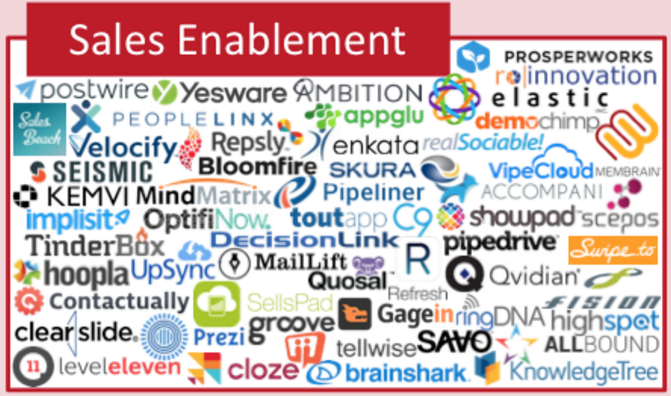Sales enablement is a “hot” issue in driving sales effectiveness/performance. Hundreds of millions are being invested in “enabling sales people.” Whether it’s new software tools, programs, content, training, processes, dedicated sales enablement professionals and executives are creating and delivering an endless array of things to “help” sales people.
Every sales enablement professional I meet is very dedicated and well intended. But often, it seems too many have lost sight of the goal–it;s helping our sales people sell more.
Too often, it seems these professionals get caught up in their own activities, which become ends in themselves, but may not be producing the desired outcomes in the sales organization.
Content is one of my favorite areas—sales enablement seems to be producing endless amounts of content. Case studies, presentations, playbooks, battlecards, proposal tools, testimonials. All are segmented by persona, industry, market, problems. Yet when one starts auditing content utilization, we see the same thing—people are only using a small amount of content. Or they are doing their own thing.
Training is the same, we’re providing more and more training, leveraging technology to deliver bite sized modules to the sales person’s device, creating just in time elearning modules to develop people’s skills. Sometimes we “mandate” the training, or require some level of certification. But then we watch sales people as they work, many simply aren’t using it.
Tools is another area. The “sales stack” has entered our vocabulary, and so many of the conversations among sales enablement professionals end up being, “mine is bigger than yours…..” As a sidenote, the picture accompanying this post demonstrates a symptom of the problem. Sales enablement isn’t about all the technology platforms we provide, but how what technology we do provide helps sales people improve their performance.
Every sales enablement professional I encounter is crazy busy–all creating new programs and new initiatives to help the sales people. I sit in quarterly executive reviews and see the sales enablement people listing all the new programs and initiatives they are creating and driving. And, again, all well intended.
But results aren’t changing. We see YOY declines in people meeting quota. We see churn in the sales organization, with job tenure going from 26 months, to 22, to less than 20 months.
And then we audit utilization—people aren’t using the tools, training, content.
Oops, I may have misspoken. I can count on one hand the number of organizations that actually do audit utilization. Too often, sales enablement professionals are too busy doing the next greatest program, they don’t take the time to see if the “dogs are eating the dog food….” and they aren’t!
We’re forced to understand why—Are they aware of the availability? Do they know why, how, when, where they should be applying it? When applied, is it actually working-or do we need to reassess what we are doing? Are we overwhelming them and providing too much, are they confused? Are we providing programs du jour, whipsawing our people with continued shifts in focus and direction. Is what we are doing even relevant–how many of our sales enablement professionals have actually carried a bag within the past few years–or have they become so distant from the reality of what sales people face/do/don’t do, that they aren’t focusing on their worlds. Do they have the right “EQ” for the lives of sales people?
In fairness, it’s not just a sales enablement issue. It’s also a management issue–both executive management and front line sales management. Effective sales enablement requires the active engagement of these people–both in setting the priorities, and as a partner in enabling the solutions.
Front line sales management has the responsibility of reinforcing and coaching the programs created and delivered by sales enablement They also need to provide feedback on what works, what doesn’t. They need to provide feedback on where sales enablement provides the biggest leverage and what should be stopped. They have to say when enough is enough. (And sales enablement must actively seek and listen to this feedback).
Sales enablers will fail to achieve the outcomes expected if they act as entities to themselves, focusing on their activities, programs, and justifying ever increasing budgets.
I’m a huge fan of sales enablement and sales enablement professionals. Much of our own work is categorized as sales enablement. It’s an important function/job that can have huge impacts on sales performance.
However, I’m an unabashed sales enablement minimalist. We need to provide just enough, but not too much. We need to seek less to provide all the answers, but provide the capability for sales people to figure out the answers.
In the end, sales enablement exists only to serve the sales people, not executive management.

Leave a Reply